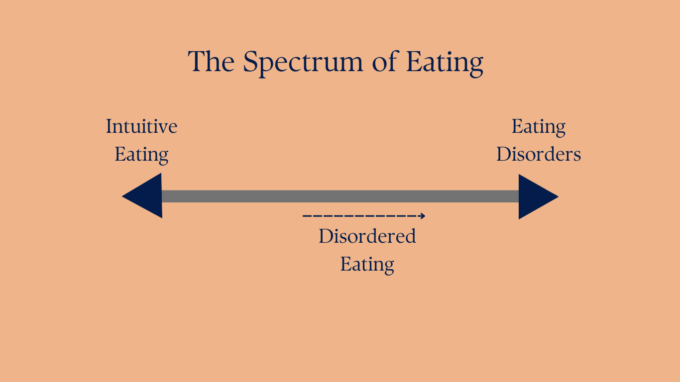
Eating happens on a spectrum.
On one side might be something like normal eating or intuitive eating. Whatever you want to call it, we are at this end of the spectrum when we are aware of and honor our body’s hunger/fullness cues most of the time, understand how different foods and food mixes make us feel, integrate sound nutrition science if desired and/or necessary without sacrificing mental health, see all foods as neutral, allow food to be more than just sustenance; eat without worry, guilt or shame; and more.
On the opposite end are clinical eating disorders (EDs). EDs include anorexia nervosa and atypical anorexia (which is actually much more common), bulimia, binge-eating disorder, and avoidant restrictive food intake disorder. Criteria to be diagnosed with an any given ED is strict by definition. EDs have the second highest mortality rate of any mental illness, lagging just behind opioid addiction. And while you might think EDs are rare, about 9% of Americans will struggle with one in their lifetime. That number is thought to be a conservative.
In between these two ends of the spectrum is a lot of gray space.
This might look like:
- Going on and off eating plans like WW, Noom, intermittent fasting/time-restricted eating, Paleo, Keto, Whole 30, etc. (and blaming yourself instead of the plans each time you go off).
- Having rigid rules around what, when and how much you eat.
- Having planned “cheat” days or meals.
- Using exercise to compensate or earn food.
- Feeling guilty, embarrassed or ashamed when you eat outside your rules/plan.
- Feeling confused or overwhelmed about how to eat.
- Feeling out of control around food sometimes.
- Experiencing a lot of inner chatter about food and body.
We end up in this gray space when we opt for eating patterns that don’t respect our bodies’ needs and/or deprioritize our mental health “in the name of” physical health. Almost everything that we are taught about food and bodies in our culture makes this gray space the norm.
Obviously, this gray space includes a ton of variability. If we eat in a way that doesn’t align with our bodies needs but the repercussions don’t greatly impact our lives, that may be just fine. For others of us, those exact same behaviors might cause physical and mental health ramifications that make it worth addressing. What might start as “casual” rule-based eating may become disordered eating, eating that includes symptoms and behaviors of eating disorders, but at a lesser frequency or lower level of severity.
The thing is, we have don’t have as much control over how we move along this spectrum as we think when we opt out of respecting our bodies’ needs. Research shows that somewhere around 35% of dieters progress to disordered eating. Of that, 30-45% of those progress to diagnosable eating disorders. This progression is not about personal choice. In those diagnosed with EDs, some combination of biology, psychology and sociocultural exposures means that “casual” dieting will most likely result in severe disturbances in eating behavior and related thoughts and emotions.
So, if you find yourself in that gray space, here is what I want you to know:
- It is not your fault. Our culture teaches us to both fear and obsess over food and to think our bodies are our projects. It has normalized looking outside of ourselves when determining how we eat.
- You are not alone. I have come across very few people who are solid normal eaters. The vast majority of people I encounter in my role as a dietitian live in the gray space or have diagnosed EDs. Personally, I struggled with disordered eating for decades though I didn’t know it until later because its so normal in our culture! I wasted so much time and energy.
- You don’t have full control about how your relationship to food progresses towards disordered eating or eating disorders. It is not your choice. If it feels hard, get help.
- It’s worth it to get curious. One of the best ways to know whether your relationship to food and body needs attention is to get curious about what happens when you don’t/can’t stick to your eating or exercise plan. Does it cause any guilt, anxiety or agitation? If so, it might be time to seek help.
- It’s possible to move out of the gray space and become an intuitive eater. It takes a lot of work for most of us. It requires rejecting our diet culture (and constantly swimming upstream against it), reconnecting with our bodies and learning to trust and respond to their signals, and more. I want to acknowledge this is hard for anyone but especially challenging for those with marginalized identities.
If you’re curious about what it could feel like to move towards a more intuitive way of eating and for your relationship to food to feel easier, I highly recommend checking out Intuitive Eating: Fourth Edition, Gentle Nutrition by Rachael Hartley, Anti-Diet by Christy Harrison and/or Just Eat It by Laura Thomas. And if you are looking for 1:1 support, I specialize in helping my clients get out of the gray so reach out.
Tell me about your relationship to food. Do you feel like a normal eater or is there anything you are struggling with?